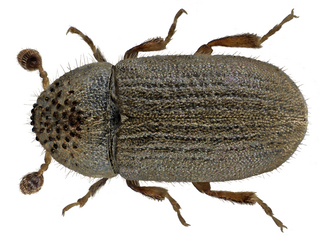Ambrosia beetles are beetles of the weevil subfamilies Scolytinae and Platypodinae, which live in nutritional symbiosis with ambrosia fungi. The beetles excavate tunnels in dead or stressed trees into which they introduce fungal gardens, their sole source of nutrition. After landing on a suitable tree, an ambrosia beetle excavates a tunnel in which it releases its fungal symbiont. The fungus penetrates the plant's xylem tissue, extracts nutrients from it, and concentrates the nutrients on and near the surface of the beetle gallery. Ambrosia fungi are typically poor wood degraders, and instead utilize less demanding nutrients. Symbiotic fungi produce and detoxify ethanol, which is an attractant for ambrosia beetles and likely prevents growth of antagonistic pathogens and selects for other beneficial symbionts. The majority of ambrosia beetles colonize xylem of recently dead trees, but some colonize stressed trees that are still alive, and a few species attack healthy trees. Species differ in their preference for different parts of trees, different stages of deterioration, and in the shape of their tunnels ("galleries"). However, the majority of ambrosia beetles are not specialized to any taxonomic group of hosts, unlike most phytophagous organisms including the closely related bark beetles. One species of ambrosia beetle, Austroplatypus incompertus exhibits eusociality, one of the few organisms outside of Hymenoptera and Isoptera to do so.

Cryphalus is a large genus of tiny bark beetles, subfamily Scolytinae, tribe Cryphalini in the family Curculionidae. The genus is widely distributed. The species feed and breed under the inner bark of trees. They infest mainly recently dead, dying or stressed trees. Some species are regarded as invasive pests, harmful to agriculture or forestry.

Xyleborini are a tribe of ambrosia beetles, highly specialized weevils of the subfamily Scolytinae. Much of the ambrosia beetle fauna in Eurasia and the Americas consists of Xyleborini species. Some Xyleborini are notorious invasive species.

Trypodendron is a genus of ambrosia beetles of the family Curculionidae. There are at least 30 described species in Trypodendron.

Conophthorus is a genus of "bark and ambrosia beetles" in the family Curculionidae. There are more than 20 described species in Conophthorus, found in Mexico, the United States, and Canada.

Scolytini is a tribe of typical bark beetles in the family Curculionidae. There are at least 50 genera and 160 described species in Scolytini.

Xylosandrus is a genus of beetles with approximately 54 species globally. The type species is Xyleborus morigerus (Blandford) 1894.

Gnathotrichus is a genus of ambrosia beetles in the family Curculionidae. There are at least 40 described species in Gnathotrichus.

Xylechinus is a genus of crenulate bark beetles in the family Curculionidae whose 53 described species include:

Pityogenes is a genus of typical bark beetles in the family Curculionidae. There are more than 30 described species in Pityogenes.

Hylastes is a genus of crenulate bark beetles in the family Curculionidae. There are more than 90 described species in Hylastes.
Premnobius is a genus of typical bark beetles in the family Curculionidae. There are more than 30 described species in Premnobius.

Xyleborinus is a genus of typical bark beetles in the family Curculionidae. There are more than 80 described species in Xyleborinus.

Euwallacea interjectus is a species of ambrosia beetle in the species complex called Euwallacea fornicatus. It is native to Asia but has been introduced to the Western hemisphere over the last century.
Euwallacea perbrevis, commonly known as tea shot-hole borer, is a species of weevil native to South and South-East Asia through to Australia, but introduced to Western countries.

Euwallacea validus is a species of Euwallacea beetle native to Asia. The beetle species was discovered in Long Island, New York in 1975. Like other Euwallacea species beetles, E. validus is known for its mutualistic symbiotic relationship with fungi, acting as a vector for Fusarium oligoseptatum and Raffaelea subfusca, often using Tree of Heaven as a preferred host. Out of the five confirmed species of Euwallacea spp. in the United States, E. validus is the most widespread and longest established, yet much about their second fungal partner, Raffaelea subfusca, is not known.













